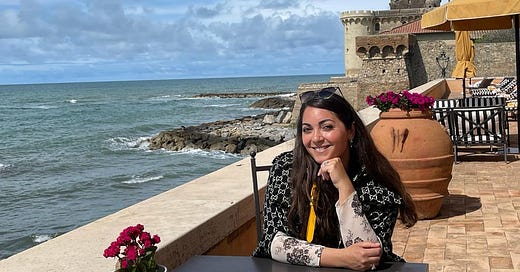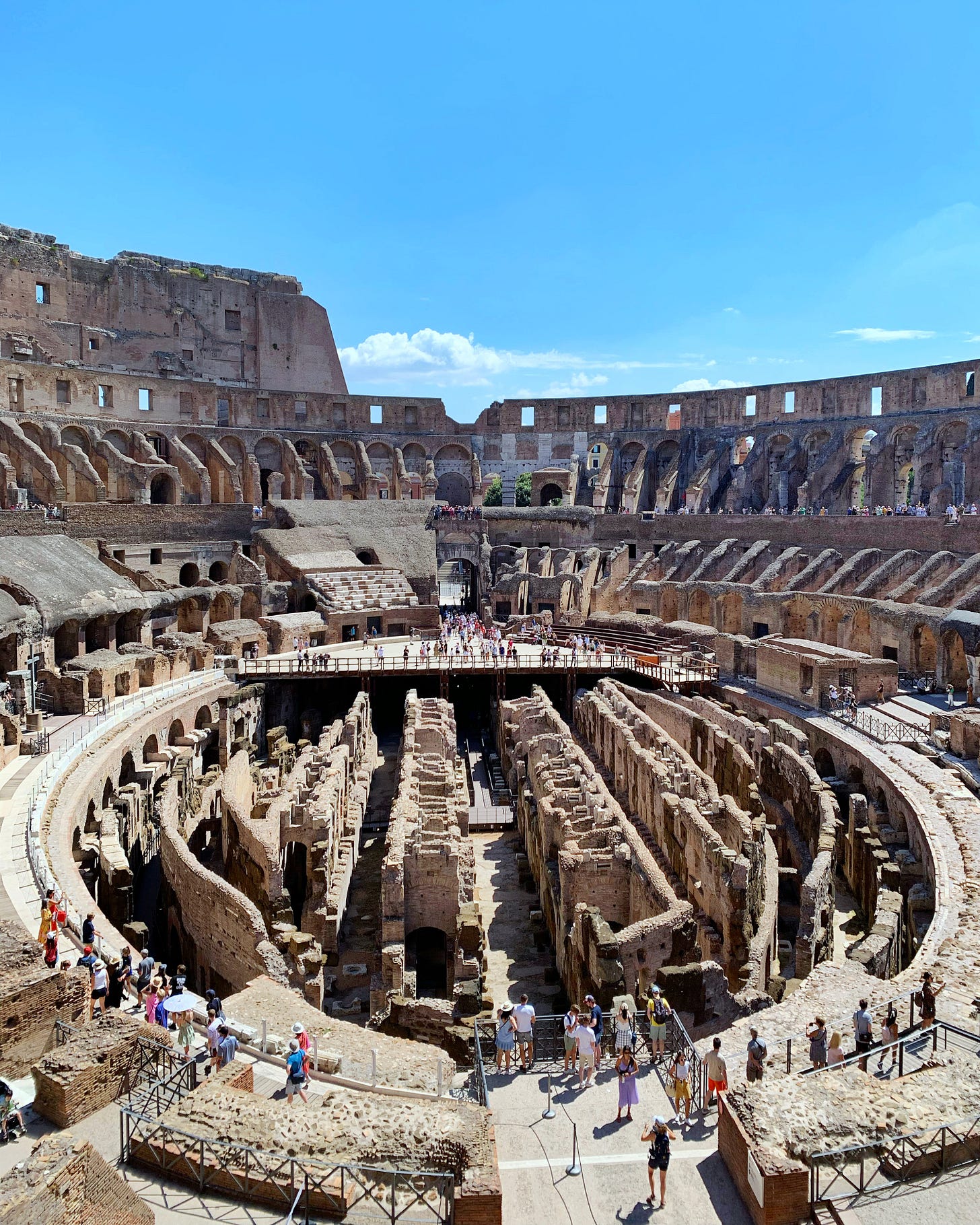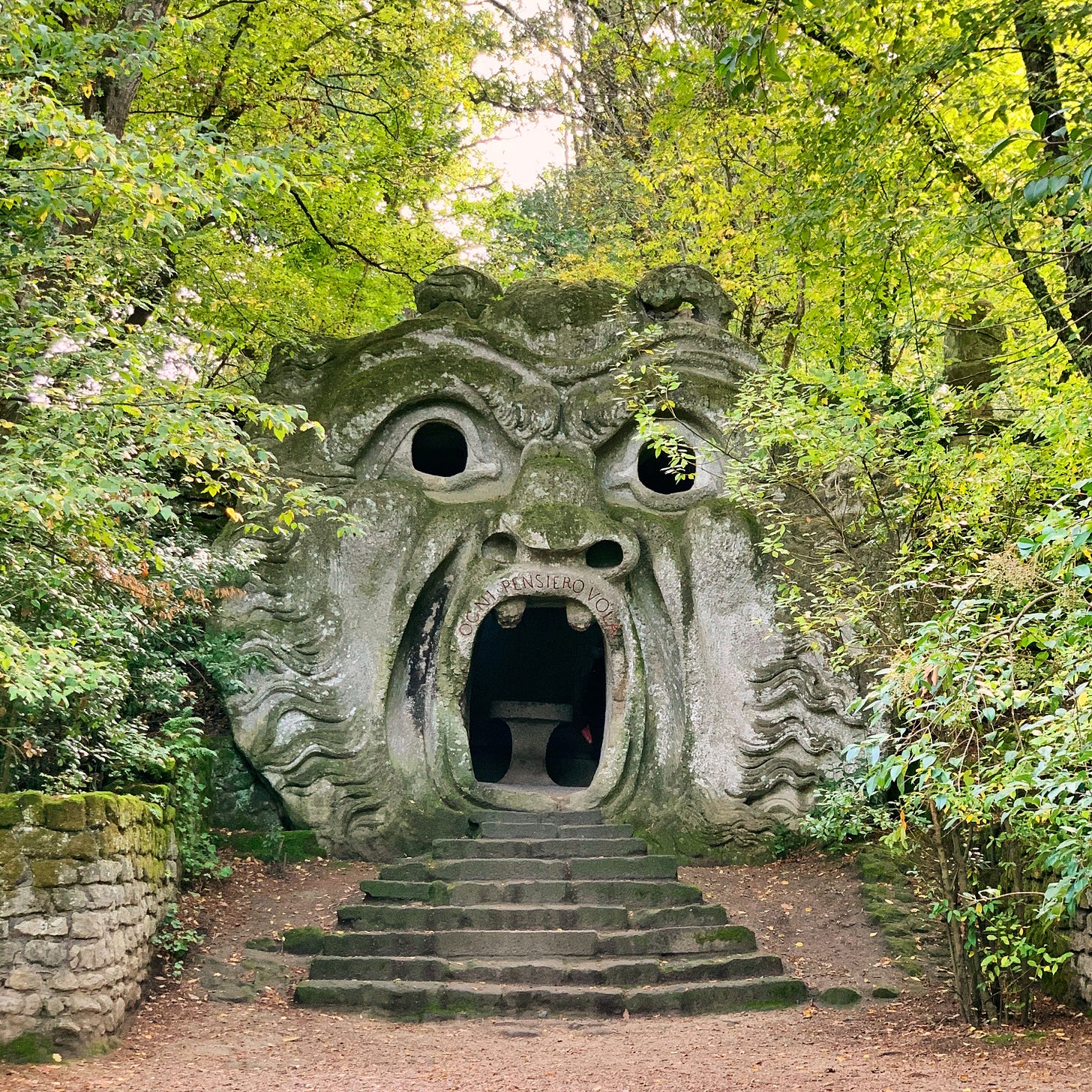One of the smartest, strongest women I know, Elisa Valeria Bove trained as an archeologist, started working as a tour guide, and eventually bought the company that employed her. Under her leadership, Roma Experience has become one of the top Rome-based tour companies. Elisa and her guides offer bespoke, private tours of Rome’s most in demand sights as well as the hidden gems that tourists don’t usually see. And she’s been steadily expanding to other parts of Italy, from the Lazio coast to Lake Como.
I first met Elisa when she won a competition by Lazio’s tourism board that aimed to give the region a post-pandemic boost and support tourism beyond Rome. I joined her on an eye-opening trip to Tuscia—the area between Rome and Tuscany—that included visits to ancient Etruscan sites, the splendid Villa Farnese in Caprarola, the Parco dei Mostri in Bomarzo, and not one but two noble palaces and a night in an 11th-century castle. Since then, I’ve toured the Colosseum, Roman Forum, and Palatine Hill with Elisa, attended a wine tasting she organized in a wunderkammer in Trastevere, and took a day trip to discover Ostia Antica, a fascinating archeological park just an hour from Rome. I recently caught up with her between tours and am thrilled to share her story as part of my series of interviews with creatives and entrepreneurs in Italy.
People who work in tourism come from all different backgrounds and your background happens to be in archeology. Where did your interest in archeology come from?
I was three years old and my parents brought me on a trip to the U.K. We were visiting the British Museum, so we were in the Egyptian collection and I was struck by lightning. Since I was three years old, I wanted to be an Egyptologist. I have all physicists and engineers in the family, so I was the black sheep because I was the only one interested in the humanities. I was very stubborn, so I grew up and wanted to be an archeologist, so I moved to Rome when I was just 18 years old and I studied at the University of La Sapienza. So the work I’m doing now is connected with my background as an archeologist.
I know you have done some archeological digs in and around Rome. You’ve dug in the Roman Forum and Ostia. Are there other places?
I can say that my favorite is in the Roman Forum because it was so complicated and fascinating. You can touch the history with your hands. Plus, when you’re there at 7 o’clock in the morning without tourists, it’s totally different. It's like you can reach the essence of the Eternal City. So it was very special. It gave me a lot and it’s giving me a lot still nowadays because when you’re bringing tourists to the place where you dug, it’s like you’re welcoming somebody to your home. The effect is different. Even the result. I think people can feel that you have a special connection with the spot.
I definitely could feel that when you brought me to the Roman Forum and also to Ostia. You bring them to life, which is not always easy. Visiting these ancient sites, there’s not a lot of signs. If you’re standing there it’s quite hard to know what’s what and the significance of these places. So to be there with somebody like you who has actually dug there and spent so much time studying the ancient temples and all the different types of buildings and their uses is really interesting.
Thank you. It’s different when you’re with a tour guide because the placards are not always accurate and they’re not connecting the monument with the history of the people. A guide can connect you with the ancient time and the way that the Romans lived.
So I’m curious, how did you decide to pivot from archeology to tourism?
I became a tour guide when I was studying at the university. I started a PhD and didn’t finish and on the weekends I was a tour guide. When I started to work in English—because the first two years I was a tour guide only in Italian—I got a lot of work and I was very passionate about it.
Because anyway I was in between the monuments and I loved to stay with people and learn more about their countries. Because when I’m with people, they’re contributing a lot. There is a lot that the tourists are giving to the tour guide, even asking questions, because I don’t know everything and I can always learn. It’s very stimulating to have this relationship with people. So I love my job. I have loved it since I started and so I decided to continue. Afterwards, I started with a company, which is another job. I started with all of Italy, not just Rome.
Yes, so when did you acquire Roma Experience and how did that come about?
I know this is crazy, but during the pandemic. Because I worked a lot for Roma Experience as a tour guide, so when the old partners were going to change jobs because the pandemic was very bad, they asked me if I was interested in Roma Experience and I said of course because I had a very good relationship with this agency.
I transformed the agency a lot because before it was doing more group tours, so I started to modify and introduce new tours based on my experience as an archeologist. And of course, you know because you have been on the trip with me, even to the hidden parts of Italy. That's the thing I love the most, when people are surprised about something they don’t know.
Yes, definitely. I wanted to talk to you about that because that’s something I really appreciated. I’m curious to know first, what are your most requested tours? I’m guessing it’s the famous places.
The Vatican and the Colosseum. The underground is my passion because as an archaeologist, of course, it’s the place I know the most and it’s even connected with the Roman Forum. And the Vatican is of course very important because many of the people that are coming to Italy are coming for a Christian trip to meet the pope. We’re in Rome, we always have the Vatican here and the pope here. For us it’s normal. But it’s not normal for people coming from other countries. I can say that I've probably been to the Vatican at least 500 times in one year, so in the 14 years that I’ve been a guide, I've seen the Sistine Chapel more times than Michelangelo for sure!
There’s even other stuff that is becoming more popular. For example, I introduced a new tour about Roman architecture. There are so many architects booking that tour, doing the Pantheon, the Colosseum, the aqueducts. There are other tours requested, but clearly all the people coming to Rome for the first time want the Vatican and the Colosseum, so you can’t escape from that.
I love the idea of this architecture tour as well. I didn’t know you’re doing that. What are some of your favorite hidden gems or less visited sites that you like to bring people to?
I like the Caravaggio tour very much because you can see in depth the history of this super skilled artist who had a dark side. For example, last October, I did a unique tour that nobody else does: all the Caravaggios of Rome. It's a gift even for me. Imagine that I’ve never seen all the Caravaggios all together, so it’s something very special. Even the guides can learn a lot. There are always different connections you can put together. So that one was very special.
And the other one I adore—maybe my favorite, because it’s one of my favorite spots—is the Appian Way, the Quintili’s Villa and afterwards the wine tasting by Prince Alessandro. So you can mix archeology and wine together; there is a more educational part and a fun part, but it’s something authentic.
That is something I like very much because when you’re in the Vatican and the Colosseum, yes, you know the history of the spots, but the incredible amount of people sometimes can change the experience. There you’re almost alone and you're surrounded by nature, monuments, oenology. So it’s incredible because you can do something different.
I want to do that tour with you!
You will do it! When I have a free moment we will do it immediately. And even being alone in the catacombs. That one brings out my Indiana Jones side. I must be honest, when you start to be an archeologist at the beginning, when you’re a kid, you’re looking to be like Indiana Jones and the reality is very different. Instead, with this you’re back to being Indiana Jones, like in your dreams.
So it’s quite funny because you wear hard hats, you enter with a torch alone inside. It’s amazing. When I see the enthusiasm of the people who say, “Wow, oh my goodness, I didn’t expect something like that,” it makes me so happy because the joy in people's faces can transform the day of a tour guide. We’re not living just to explain monuments but for the appreciation of the people for what we’re doing.
I know you also do many tours outside of Rome. Even if the company is called Roma Experience, we met initially doing the tour in Tuscia, which you organized. Where else do you bring your clients?
We have tours all over Italy. Clearly, being in Rome, when I’m moving around, I’m going to Tuscia, the Latium coast—these are of course very popular from Rome because they’re just one or two hours away and not very close to the touristic areas, so a much more pristine part of the region. It’s very interesting because you can even touch the culture of the Etruscans, who influenced the city of Rome. Do you know, for example, that the sewer system was created by the Etruscans? So you can reconnect a lot of the skills that the Romans had.
But I’m doing even Lake Como. There’s a lot of requests, especially in this period, for amazing boat tours. Or Milan, with the Last Supper. Venice. Even Vicenza, Verona. This year we introduced some new destinations. Naples or the Amalfi Coast, Florence and the environs. Siena. We have an incredible variety. We’re working everywhere. Clearly we’re specialized in Rome, but often the people who are coming know that we do other destinations so they ask us for a full itinerary so we’re working to discover other areas that are not just in this region.
Among my readers who I’m interacting with in this newsletter, I think people are very interested in learning about under-the-radar places in Italy. And instead of doing the classic Rome, Florence, Venice itinerary, some people are going to Rome and then Puglia or Sardinia, and I think this is an interesting change. I’m curious if you’re seeing something similar with your clients.
I can say that Rome has been for a long time a destination for a short time—two or three days—and then people were leaving. The pandemic changed a lot of things because people started to slow down, to spend more time in the same spots. This year we have to face a gigantic problem, which is in all the newspapers, the issue of the tickets for the Colosseum and the Vatican. They are totally sold out.
Sometimes people ask for something different because they don't want to be stuck in a place with 40,000 people around, so they’re starting to ask for off-the-beaten-path places. So of course we’re there to suggest more hidden spots. And it’s true that we’re seeing people doing Rome and then flying to Sicily or going to other destinations like spending more time in Tuscany or Lake Como. So they’re pairing Rome with something else.
But this year is the first year in 14 years that I can say that the most requested city is Rome. I think it was even elected the fourth worldwide destination. Rome was hit so hard by the pandemic, that many people wanted to see Rome for this reason and in some ways give some support to the people living in Rome, so they’re staying longer than the usual two, three days.
I think that’s good because, honestly, how can you possibly see Rome in two or three days?
It’s true. But you know, many people are talking just about the Colosseum and the Vatican. You can’t imagine how many times people ask me, “What is your favorite place in Rome?” And I answer Quintili’s Villa and they look at me like, “What is Quintili’s Villa?” So they don’t know at all about the other spots. And so they’re all surprised. So we need people to talk about off-the-beaten-path places.
Absolutely, I agree. And I try to do that in my work for the magazines that I write for and also in this newsletter. So for the people who are coming to Rome or Italy this summer or fall, which we know is an extremely busy season, what advice do you have?
My advice is to ask your tour operator to search for different paths, not just the Colosseum and the Vatican, because there are amazing spots, like the Circus Maximus and the Appian Way, where there is nobody and you can have the same feeling if not better than the well known monuments. There is always an alternative and an authentic way to visit Rome other than the common spots. So don't give up when you see that the tickets are sold out. We can find a different solution with amazing itineraries that are no less interesting than the famous ones.
You can start a new trend, the off-the-beaten path trend where you do something that others are not doing, and that is the real VIP experience. You can see something different. And plus, like what I told you about Tusica, try to search for a connection, because for example, many people don’t know Caprarola, which is unbelievable. In my opinion, it’s even far better than the Vatican. So try to explore different spots because you will be surprised. Surprise yourself.
I know that you—like me—enjoy good food and wine, so would you share a few of your favorite places to eat and drink in Rome?
I have so many. A very good place for me, because I love fish, is the Tempio di Iside, which is not far from the Colosseum. I know that I must be obsessed with Egyptology because the restaurant is very near a temple dedicated to Isis, but the food is so amazing. They have a real respect for the materials. I like another one very much that is also near the Colosseum that’s called il Bocconcino, where they’re revisiting traditional Roman recipes. And Rome has amazing terraces and restaurants with views. One I adore is AcquaRoof, which is inside the First Hotel. There is the Michelin-starred restaurant Acquolina, which in my opinion is the best one in Rome. These are the places I love.
Thank you so much, Elisa. It’s been so much fun to talk with you today.
Even for me, thank you. I hope I didn’t spoil too many secrets.
This interview has been condensed and edited for length and clarity.
Further Reading
Want to learn more about Tuscia? I wrote a short piece about it for the October 2022 issue of Hemispheres and a longer feature for Fodor’s.
When I was tasked with writing a roundup of the best Colosseum tours by my editor at TripSavvy, Elisa brought me on an unforgettable tour of the ancient monument and its underground passageways.
Elisa organizes 6 a.m. tours of the Vatican for VIP clients. You can read more about that experience here.
Elisa has shared her expert insight for several past issues of this newsletter, on topics such as Rome’s essential neighborhoods, the mysterious Roman origins of Valentine’s Day, and the role of dogs in Rome, from antiquity to today.
You can see all the other interviews in this series here.










